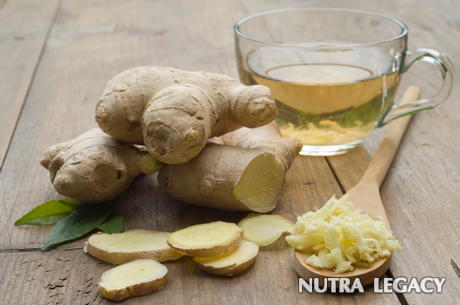Ginger (In a Snap)
For many, “ginger” is simply a somewhat derogatory nickname for redheaded, freckled children. For others, the word refers to the bitter, pickled and usually uneaten section of a sushi platter. Of course, there’s ginger ale and ginger snaps and ginger bread as well. In today’s information flooded society, all of the above are true. However, the traditional and most valuable form of ginger is still the raw underground stem of the Zingiber officinale plant—a wonder for countless medicinal and gastronomical applications throughout Chinese, Indian and Arabic cultures for over four centuries. Although the plant is native to Asia and flourishes in moist, tropical soil, the use of the root for culinary purposes and in nutritional supplements is now commonplace across the globe.

One can recognize ginger by its milky beige color and knotted underground stem. Sometimes, white, yellow or green flowers extend from this dense root. Although the taste of this incredible rhizome is both unique and, in many cases, acquired, the health benefits may outweigh the cooking utility. It is classified as a carminative, diaphoretic and anti-inflammatory herb. For over 2,000 years, ginger has been used to combat a myriad of conditions including diarrhea, nausea, arthritis, colic, cold, flu, heavy and/or painful menstrual periods and even plain old headaches. In addition, ginger is increasingly supplementing treatment for heart conditions, chemotherapy symptoms and vomiting during pregnancy.
According to information provided by the University of Maryland Medical Center, “The important active components of the ginger root are thought to be volatile oils and pungent phenol compounds (such as gingerols and shogaols).”
For those looking to inject their lifestyles and culinary creations with a little pizzazz, ginger is available as an extract, tincture, capsule, oil, spice or fresh root. It can also be prepared as a tea—specially designed by nature for relaxation and soothing upset stomachs or menstrual cramps. Natural food sources rarely contain more than 0.5 percent ginger. So, it’s nearly impossible to exceed recommended dosage (around 4 grams per day).
NOTE: Ginger should not be given to children under two years of age. After that point, the recommended amount is roughly 1/3 of the adult dosage.
The information supplied in this article is not to be considered as medical advice and is for educational purposes only.
|
| ||||||||||||||





 25 Jul 2014
25 Jul 2014